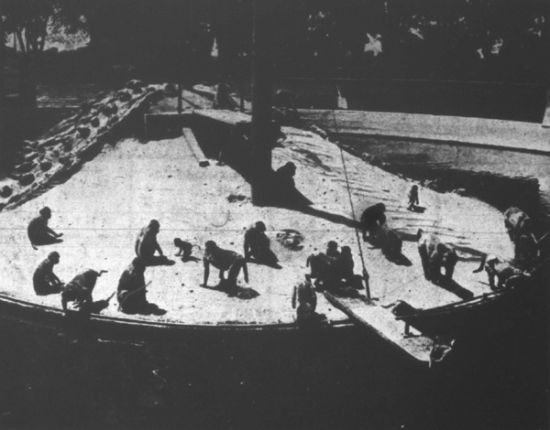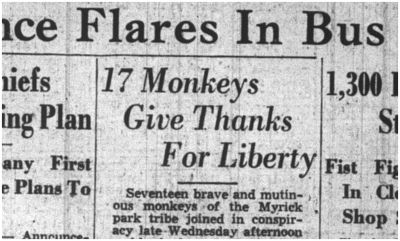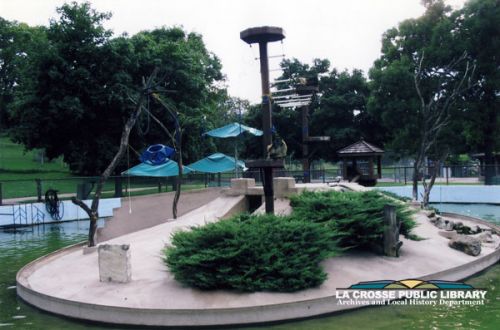
Monkey Business
(written by Barry McKnight, Archives staff)
Many longtime La Crosse residents feel nostalgia for the Myrick Park Zoo, in particular the Monkey Island attraction. From the time the Monkey Island was created in 1929 until the city ceased management of the Myrick Park Zoo in 2007, the monkeys were the main attraction and perhaps the thing visitors remembered most. As talk and action in the community moves toward bringing the zoo back, a look at its historical centerpiece is in order.
As early as 1924, a Monkey Island was planned for Myrick Park. Proposed by Alderman William Roellig, the initial plan was to place it in the lagoon at Pettibone Park. After conferring with zookeepers at Milwaukee Zoo, it was determined that the location was too damp for housing monkeys and Myrick Park was deemed a more suitable location. The city engineer drew up plans for the island in a pond surrounded by a wall that would be 2-3 feet above water. The island was to have a high mound of earth in the center with a cave for the monkeys to shelter in, along with some trees. The city’s greenhouse would house them in the winter. In 1929, work began in earnest and the costs of construction were paid by the Veterans of Foreign Wars.

La Crosse Tribune Aug 26, 1929
Dedicated on August 25, 1929, it was seen as the beginning of a great zoo. In a ceremony attended by a crowd of over 1000 people, the island was formally turned over to Myrick Park and the city. Thousands more viewed the attraction and its initial dozen monkeys later that day. According to the La Crosse Tribune, the monkeys “twisted and twirled in the two pipe Ferris wheels, then capered across the rope ladder stretched between the two trees on the island” to the delight of onlookers. Other than an initial warning in the newspaper to leave the fish in the island’s moat alone, the exhibit seemed problem-free. Myrick Zoo and its Monkey Island proved to be popular to residents and tourists alike. In 1931, it was estimated that 22,000 people visited the zoo and its main attraction. By the end of the 1930s, that number had increased to almost 27,000.

La Crosse Tribune July 13, 1952
There were challenges in keeping monkeys, however. Brought in primarily from Central and South America, the herd consisted mostly of spider monkeys. Due to their territorial nature, the monkeys had to be purchased as a group. Breeding amongst themselves, the herd would grow in size until problems emerged. Inbreeding and violence necessitated either the selling or destruction of the old herd and the purchase of a new one. In a La Crosse Tribune article from October 18, 1957, city park director William Krueger, detailed the problem, stating that the then 22-year-old monkey herd had “become so inbred that it was impossible to put them into show condition.”The inbreeding caused them to become “unmanageable” and led to the female monkeys killing the males. This was a problem that occurred a number of times over the life of the zoo.
Initially, the monkeys were kept during the winter months in what is now the Pump House Regional Arts Center. When this proved impractical, they were moved to the La Crosse Animal Hospital, then at 708 N. 3rd St. It was there that the most famous story related to the Myrick Park monkeys occurred.

La Crosse Tribune Nov 25, 1937
Around 4:30 p.m. on November 24, 1937, fifteen monkeys from the herd escaped when the door to their pen was left open. The escapees spent the night on the roof of the neighboring Jagow Advertising Company. The next morning, they ran across Third Street to the shelter of the Northern States Power gas plant. There they climbed the 120-foot gas holders and ran along pipes, evading capture. The escaped monkeys drew a crowd of onlookers and traffic on North 3rd Street. was blocked by cars and pedestrians. This may have prolonged their escape. According to Dr. Chester Heth, the then-owner of the La Crosse Animal Hospital, monkeys “are smart and hate to be started at,” putting a somewhat grim light on their captivity and use as an attraction.
By the morning of the 26th, all but three of the monkeys had been recaptured. Of the remaining three, the first was recaptured after invading the pattern department of the nearby Allis Chalmers Company at 501-529 N. 3rd Street, which led to a desperate call to the police. The second was recaptured after a missed jump led to him falling 120 feet to the ground. Fortunately, the monkey was only stunned. The last was caught after a traffic-blocking standoff on the guy wire above North 3rd Street. Later, the monkeys, along with other animals, would spend their winters at the city’s experimental farm on Grandad Bluff, then moving to converted maintenance building in Myrick Park in 1982.
The monkey exhibit faced other challenges over the years. In 1944, a La Crosse police officer sustained a broken rib when he entered the monkey enclosure after being called to shoot a monkey suffering birth pains. In 1983, the only male monkey at the time was killed when a wind deflector in the exhibit fell over while schoolchildren were touring the park. Several times, patrons who broke the rules and reached into the enclosure were bitten. In a 1996 La Crosse Tribune article, La Crosse Park Superintendent Gar Amunson said that the monkeys “present numerous problems” for the zoo staff. “They can get so darn cantankerous, biting the keepers and so forth,” Amunson said. “There’s a debate about should we look at something else.”

Monkey Island with visitors, August 1961
The care of the monkeys and other animals was expensive and, since admission to the park was free, costly to the city. Additionally, none of the workers tasked with the care and feeding of the animals were trained biologists or zoo-keepers and instead came mostly from other city departments, such as Parks or Streets. This occasionally led to problems and criticism, newspaper editorials and complaints that the animals were not being cared for properly. These increased in frequency over time.
Over the years, other animals also escaped or were harmed. For example, in 1956, two timber wolves escaped into nearby neighborhoods, and in 1977 a bobcat was killed and his remains stolen. In 1988, the popular black bear Roscoe was retired and traded for two yearling cubs. Shortly after being relocated to a game farm, he was killed after being deemed “not suitable for breeding.” A La Crosse Tribune investigation revealed that the owner of the game farm had previously been found guilty of bear trafficking in 1986, shipping dead bears and bear parts to Korea. As part of the trade with the Myrick Park Zoo, the game farm was entitled to any cubs birthed after the yearlings came of age. In 2009, a wild black bear wandered into the park, probably attracted to the two female bears in their enclosure. After a chase, he was treed and shot by police, in front of a crowd of park visitors.

Monkey Island, 2006, shortly before its closure
In 2007, as plans for the new Myrick-Hixon EcoPark were under way, the city ended its management of the zoo. EcoPark organizers planned to retain some of the animals that were native to this region as part of park and the remaining monkeys were transferred to a zoo for aging animals in Greenville, Wisconsin.
In April 2015, a Bring Back the Old Myrick Park group was organized, with a Facebook page, supported by those who want their children and grandchildren to experience the zoo they remember from their youth. Fundraising has begun and such a project will be undoubtedly be expensive. Standards have changed, and maintaining a zoo, even a small one, is costly in terms of housing animals humanely attended by trained staff. Time will tell if they are successful in their efforts.

